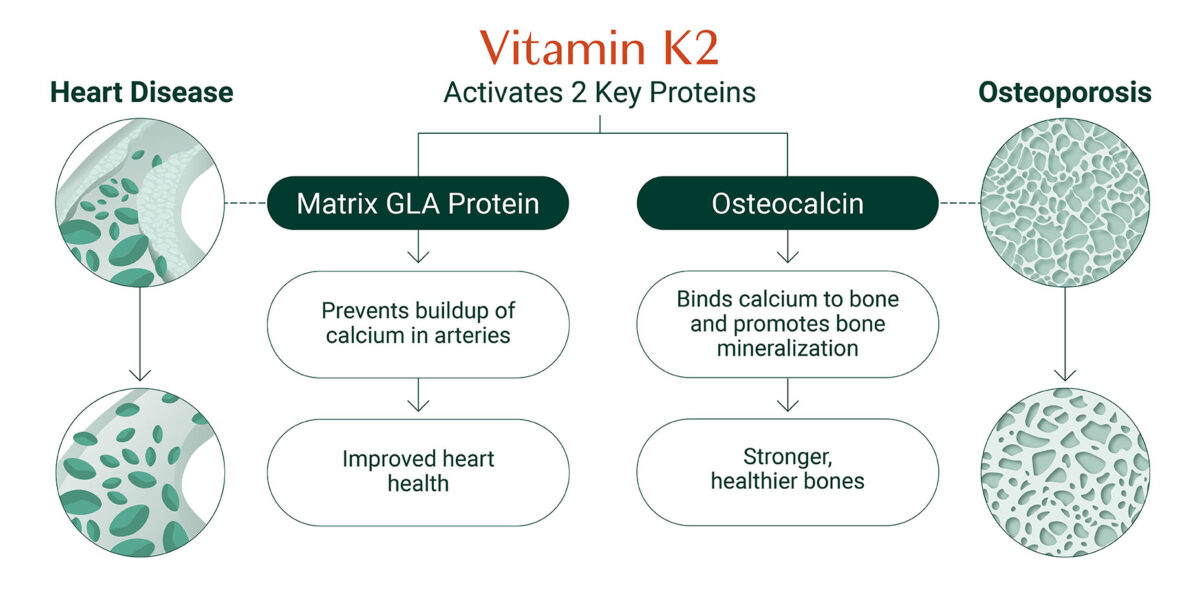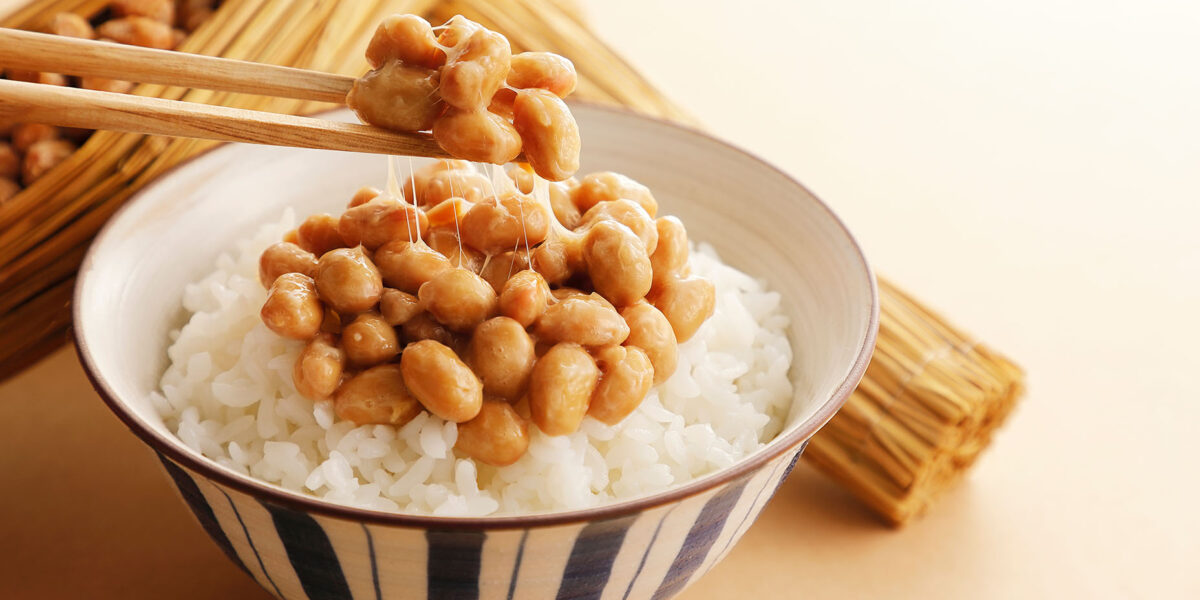Vitamin K is a dynamic nutrient that comes in two forms that display unique properties and play important roles in bone health: vitamin K1 (phylloquinone) and vitamin K2 (menaquinone). What many people don’t realize, however, is that vitamin K2, the menaquinones, appears in at least 15 different forms! In relation to bone health, the two most well-studied menaquinones are MK-4 and MK-7[1].
Each of these forms of vitamin K has a unique chemical structure and, therefore, its own activities, unique benefits and uses.
In this article, we will focus on these two different forms of vitamin K2 and discuss how each form is metabolized within the body and the proper dose of each likely to provide benefit for our bones.
Vitamin K2 and Bone Health
Vitamin K1 is well-known for its role in activating the clotting factors that prevent us from bleeding out from even the tiniest paper cut. Vitamin K1 also helps lower inflammation; that’s the role in which this form of vitamin K supports bone health. Vitamin K2, however, is the primary form in which vitamin K is a crucial nutrient for our bones because K2 regulates the healthful use of calcium within the human body[2].
Specifically, vitamin K2 helps with bone mineralization by activating a protein called osteocalcin, which binds calcium and ferries it into our bones. Osteocalcin is secreted by osteoblasts, our bone-building cells. Once activated, osteocalcin helps bring calcium into our bones, enhancing bone density and strength.
Vitamin K2 also prevents calcium from depositing where we don’t want it. Vitamin K2 does this by activating another protein called Matrix-Gla protein (MGP), which prevents calcium from depositing in soft tissues, like the blood vessels in our cardiovascular system and kidneys, and protects them from calcification and stiffening. As such, this protein, once activated by vitamin K2, provides protection against cardiovascular and kidney disease[3][4].
Working in tandem, osteocalcin and MGP ensure calcium is delivered into your bone matrix and kept out of your heart, blood vessels, and kidneys. None of these activities can be accomplished without the help of vitamin K2[5].

The Two Forms of Vitamin K2: MK-4 vs MK-7
As mentioned previously, the two best-studied forms of K2 are MK-4 and MK-7. While these two nutrients are both menaquinones, there are some significant differences in their structures that impact how long they remain available in your body. Let’s dive in.
Role of Vitamin K2 MK-4
MK-4 is smaller in structure than MK-7 and is actually almost identical in structure to vitamin K1. Both MK-4 and MK-7 are used for activating blood clotting proteins before they are used for bone health.
Once all your blood clotting needs are taken care of, any leftover MK-4 can be packaged up into triglycerides and used for bone health (activating osteocalcin and MGP) – but there’s a catch.
Triglycerides don’t stick around in your blood for very long; they are either rapidly used up for fuel or stored in your fat cells. As such, MK-4 gets cleared from your blood within six to eight hours maximum.
Role of Vitamin K2 MK-7
Like MK-4, MK-7 will be used first to activate blood clotting factors if that need exists. Leftover MK-7 will then move on to support bone health.
Although both MK-4 and MK-7 can activate osteocalcin and MGP, MK-7 remains available to support the healthful use of calcium in your body far longer than MK-4. While MK-4 is packaged into quickly used or stored triglycerides, due to its larger structure MK-7 is packaged into cholesterol, in which it travels around your body for several days. This not only gives your bones more time to utilize the MK-7 you get from food or supplements, but it also enables your body to accumulate a “savings account” of MK-7 that you can always draw from to keep your osteocalcin and GLA matrix proteins firing at all times.
Which Is Better for Osteoporosis, MK-4 or MK-7?
Because MK-4 is cleared from the body in 6-8 hours, it must be taken several times each day and in far larger doses than MK-7. Because of MK-7’s far longer availability, much smaller doses provide constant support for osteocalcin and MGP activation. For this reason, MK-7 is the superior form of vitamin K2 to support bone health, especially through the lens of osteoporosis.
Osteoporosis occurs when your bones lose their mineral density and become weak and brittle. As you just learned, vitamin K2, particularly MK-7, plays a crucial role in enhancing bone mineral density by increasing calcium uptake[6][7].
Bone mineralization must be in healthful balance with bone breakdown for someone looking to overcome osteoporosis or even the beginning stages of osteopenia. This means that providing your body with a steady stream of nutrients to enhance bone health is essential.
With MK-7, your body will receive a lasting supply of vitamin K2, as opposed to MK-4, which you’ll need to replenish several times each day.

Natural Sources of Vitamin K2
Vitamin K2 can be found in a variety of animal food sources, but very few contain enough of this nutrient to support bone health on their own. While K1 can be converted to MK-4 and be used for bone health after your blood clotting needs are taken care of – if your digestive tract is well populated with the health-promoting bacteria that do this job – and certain animal-derived foods, such as pastured eggs, grass-fed butter, meat, and certain cheeses contain small amounts of MK-4, you would have to consume very large amounts of these foods to provide enough MK-4 to reliably support your bones’ health.
The one known food source that contains enough MK-7 to take care of your bone health needs is a Japanese fermented soybean product called natto. Natto contains 380 micrograms of MK-7 in just 1.4 ounces.
Foods that contain vitamin K2 in the MK-4 form include:
- Egg yolks (1 ounce) 4.4 to 9 micrograms
- Chicken liver (4 ounces) 14.4 micrograms
- Chicken breast (4 ounces) 10 micrograms
- Ground beef (4 ounces) 7 to 9.25 micrograms
- Meat franks (4 ounces) 11.2 micrograms
- Sauerkraut (3.5 ounce) 4.8 micrograms
As you’ll soon see, none of these sources would have enough MK-4 to meet your nutrient needs for bone health.
MK-7 and MK-4 Dosage and Supplementation
When assessing the appropriate dose of MK-7 and MK-4 for bone health, we have to keep in mind two things:
#1: What each form is preferentially used for
#2: How long each form stays in the blood and is available to activate bone-building proteins
In the case of MK-4, studies show that you would need 45,000 micrograms a day (or 45 milligrams) divided into 3 doses, one taken every 6-8 hours, to provide benefits for osteopenia or osteoporosis.
In addition to the very large overall daily dose, an amount that would be impossible to consume from food, you would also have to take an MK-4 supplement every six to eight hours to ensure your levels stay high, which would mean three doses of 15,000 micrograms each day.
On the other hand, since MK-7 can accumulate in your body, you need a much lower dose, and it can be taken only once a day. In fact, a dose as low as 100 micrograms per day is typically enough to keep osteocalcin and matrix-GLA protein active.
This is an amount that can easily be supplied by your diet if you eat natto regularly.
However, as natto is an acquired taste that most people living in the West (the U.S., Canada, or Europe) aren’t accustomed to, a more practical option is to take a supplement that contains MK-7.

Takeaway
Both forms of vitamin K2 display a range of beneficial activities in your body, but MK-7 is clearly the nutrient to focus on when it comes to bone health.
This form of K2 remains available in your bloodstream for far longer and is able to accumulate, building up a buffer that ensures a steady supply. This means you can take a much lower dose and still meet your bone-building needs, getting calcium into your bones and preventing calcium from depositing in unwanted places.
Sign up for the AlgaeCal Newsletter to stay tuned in on all things bone health.






Dean Neuls
August 6, 2015 , 9:03 pmThanks for clarifying this important topic, Lara!